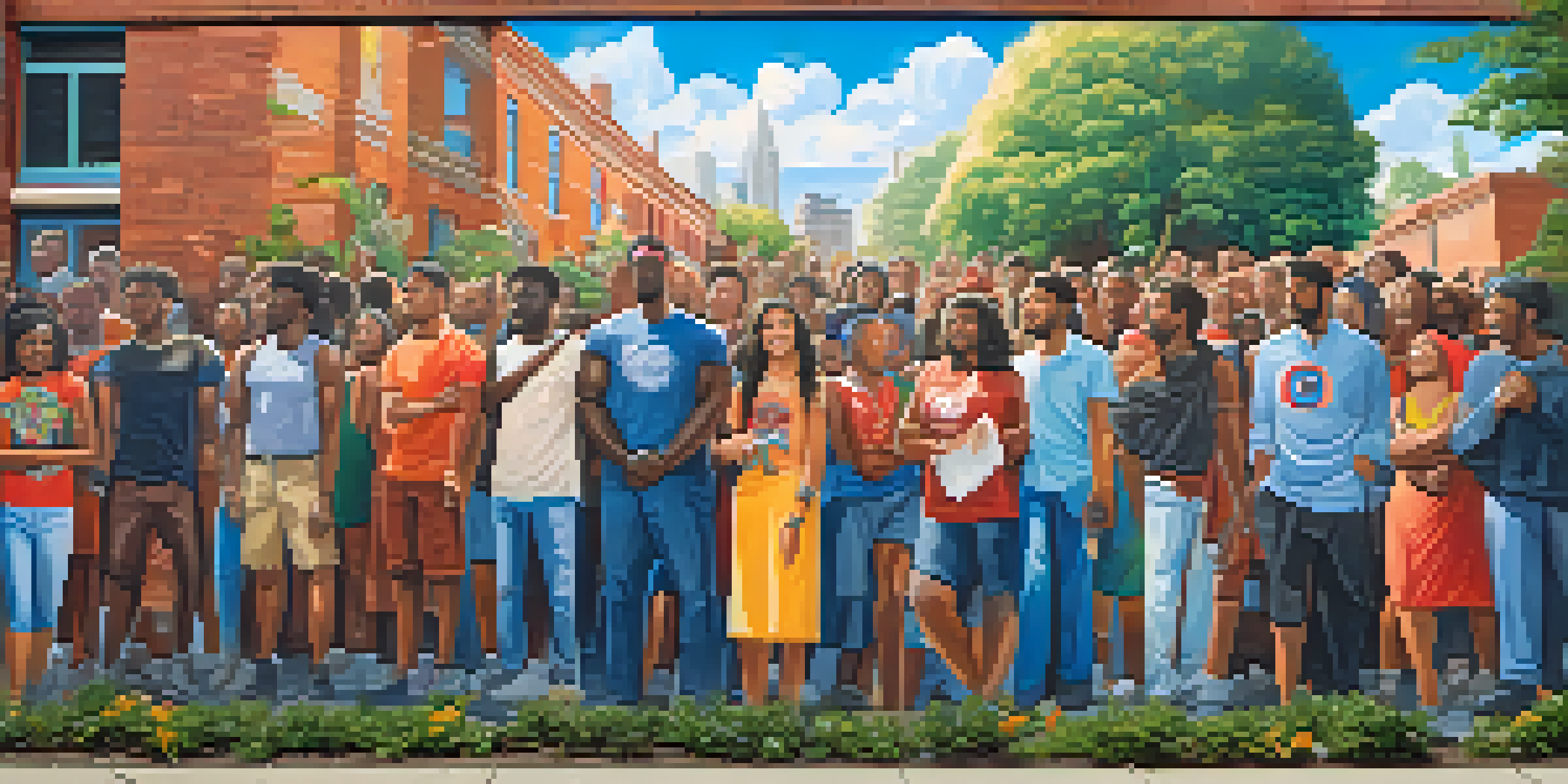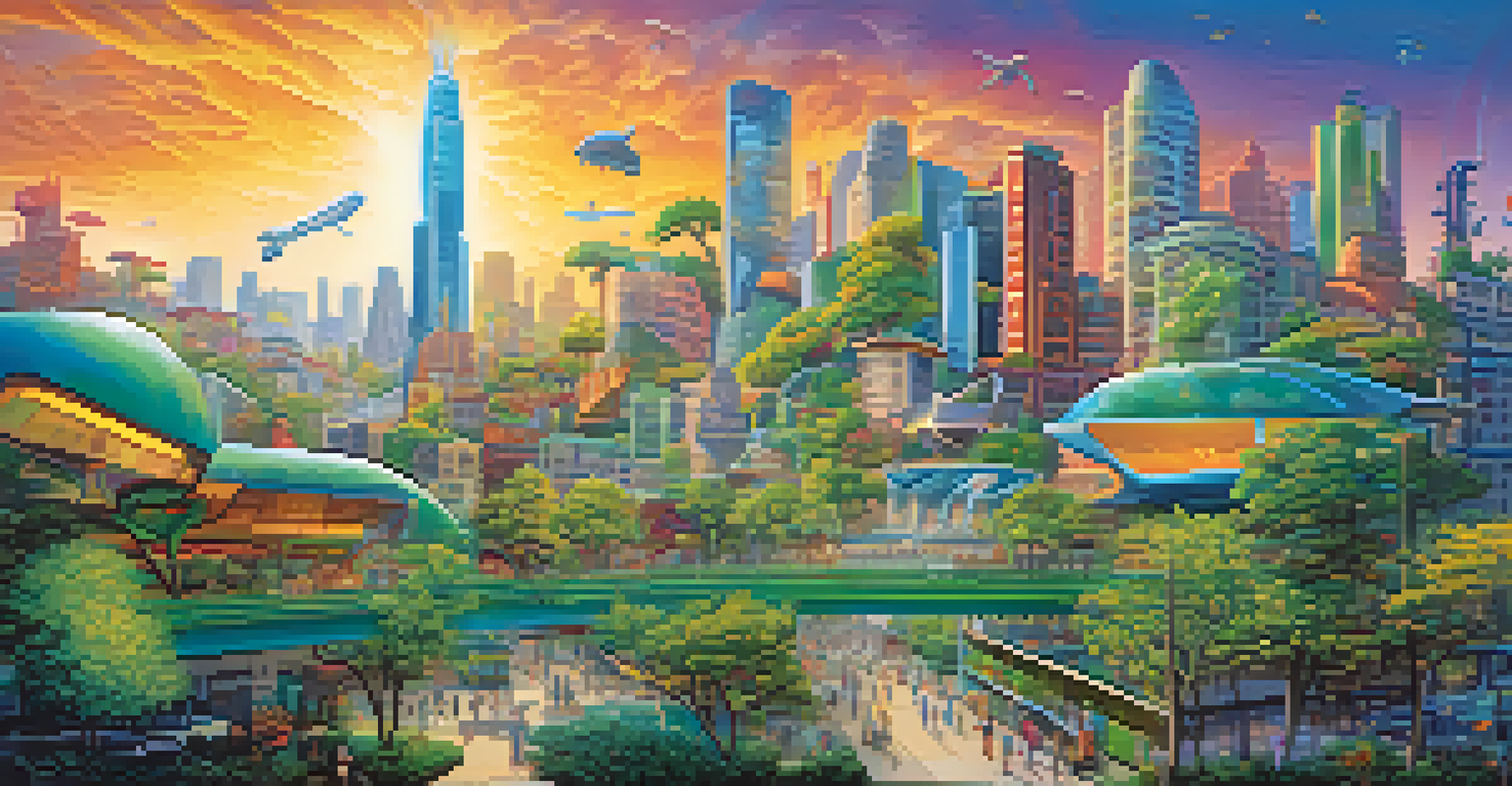Murals as Political Commentary: A Historical Perspective

The Origins of Murals in Political Discourse
Murals have been a form of public art for centuries, often used to convey political messages. From ancient civilizations like the Egyptians and Aztecs to more modern contexts, these large-scale artworks have served as a canvas for societal reflection. Their visibility in public spaces makes murals a compelling medium for reaching a wide audience, especially those who might not engage with traditional forms of political discourse.
Art is not a mirror to reflect the world, but a hammer with which to shape it.
In the early 20th century, murals became increasingly associated with political movements, especially in Latin America. Artists like Diego Rivera used murals to depict the struggles of the working class, making art accessible to the everyday person. This democratization of art helped solidify murals as a powerful tool for political commentary, illustrating the struggles and aspirations of the people.
As we trace the history of murals, we see how they adapt to reflect the changing political landscape. From celebrating revolutions to critiquing governmental policies, murals remain relevant as they encapsulate the zeitgeist of their time. This rich history underscores the importance of murals in shaping public opinion and consciousness.
Murals in the Age of Social Movements
The late 20th century saw a resurgence of murals as social movements gained momentum. Artists began using public spaces to voice their opinions on issues such as civil rights, feminism, and environmental justice. These murals not only served as a form of protest but also as a unifying force for communities, rallying people around a common cause.

One notable example is the mural movement in the United States during the 1960s and 1970s, which highlighted the struggles of marginalized communities. Artists like Judy Baca painted large-scale works that addressed issues like immigration and social inequality. These powerful images became symbols of resistance, inspiring future generations to use art as a means of political expression.
Murals as Political Expression
Murals serve as powerful tools for political commentary, reflecting societal struggles and aspirations throughout history.
In today’s context, murals continue to play a significant role in social justice movements, as seen in the wake of events like the Black Lives Matter protests. Artists worldwide have taken to the streets, transforming walls into platforms for change. This ongoing dialogue between art and activism illustrates the enduring power of murals in shaping societal narratives.
The Role of Murals in Cultural Identity
Murals often serve as a reflection of cultural identity, preserving stories and traditions through visual storytelling. Communities use murals to celebrate their heritage and express their unique experiences, making them vital in the context of political commentary. These artworks can bridge cultural divides, fostering understanding and connection among diverse groups.
Public art is a way of making a statement; it is about generating dialogue and engagement within the community.
For instance, in many Indigenous communities, murals are a way to reclaim history and assert cultural pride. By depicting traditional stories and symbols, these murals challenge mainstream narratives and highlight the resilience of Indigenous peoples. This use of public art not only preserves cultural identity but also serves as a form of political resistance against erasure.
Murals can also create a sense of belonging, as they often incorporate elements familiar to local residents. This engagement with the community ensures that the murals resonate on a personal level, transforming public spaces into vibrant areas of dialogue. As such, murals become a canvas where cultural identity and political commentary intersect.
Murals as a Tool for Urban Revitalization
In recent years, cities have embraced murals as a strategy for urban revitalization, recognizing their potential to beautify neighborhoods and promote tourism. By transforming blank walls into captivating artworks, cities can attract visitors while fostering local pride. This approach not only enhances the visual appeal of urban spaces but also encourages economic development.
However, the process of commissioning murals often involves collaboration with local artists and communities, ensuring that the artwork reflects the area's identity. This participatory approach can empower residents, giving them a voice in how their neighborhoods are represented. As a result, murals can become a point of pride and a catalyst for community engagement.
Cultural Identity Through Art
Murals preserve cultural identity and foster community connection by celebrating heritage and challenging mainstream narratives.
While revitalization efforts are generally positive, they can also raise concerns about gentrification. As neighborhoods become more attractive to outsiders, long-standing residents may be displaced. This complexity underscores the need for careful consideration when implementing mural projects, ensuring they serve the interests of existing communities.
The Challenges of Political Murals
While murals can be powerful forms of political commentary, they are not without challenges. One significant hurdle is the potential for censorship, as governments or organizations may attempt to control the messages conveyed through public art. This tension between artistic freedom and regulation can lead to heated debates about the role of art in society.
Furthermore, political murals can provoke polarized responses from the public. While some may view them as necessary critiques of the status quo, others might see them as divisive or inappropriate. This duality reflects the complexity of political expression and the diverse perspectives within a community.
Despite these challenges, many artists remain committed to using murals as a platform for social change. They navigate the delicate balance between artistic expression and community sentiment, often finding innovative ways to address contentious issues. This resilience highlights the enduring importance of murals in fostering dialogue and challenging societal norms.
Global Perspectives: Murals Around the World
Murals exist in diverse cultural contexts, each reflecting the unique political landscapes of their respective regions. In countries like Mexico, murals have a long-standing tradition of depicting revolutionary themes and social justice issues. Artists like Diego Rivera and David Alfaro Siqueiros have set the groundwork for modern muralism, inspiring similar movements globally.
In contrast, murals in countries like the United States often focus on local issues, such as racism, inequality, and environmental concerns. The themes may vary, but the underlying purpose remains the same: to provoke thought and inspire action. This global tapestry of muralism showcases the universality of art as a tool for political commentary.
Revitalization and Community Impact
Cities leverage murals for urban revitalization, enhancing aesthetic appeal while empowering local communities through participatory art projects.
Furthermore, international collaborations among artists have emerged, leading to cross-cultural exchanges that enrich the mural landscape. Artists from various backgrounds come together to create works that highlight shared struggles and aspirations. This interconnectedness fosters a sense of global solidarity, emphasizing the role of murals in uniting voices for change.
The Future of Murals as Political Commentary
As society continues to evolve, so too will the role of murals in political commentary. With the rise of social media, artists now have greater platforms to share their work and mobilize support for their causes. This digital age allows for the rapid dissemination of ideas, making murals even more impactful as tools for social change.
Moreover, the integration of technology in mural creation opens up new possibilities for artistic expression. Augmented reality, for example, can bring murals to life, offering viewers an interactive experience that deepens their engagement with the artwork. This innovation can elevate political commentary, making it more accessible and relatable to a broader audience.

Ultimately, the future of murals as political commentary lies in their ability to adapt and resonate with the changing times. As artists continue to challenge societal norms and spark conversations, murals will remain a vital part of the cultural fabric, reflecting the hopes, struggles, and aspirations of communities around the world.